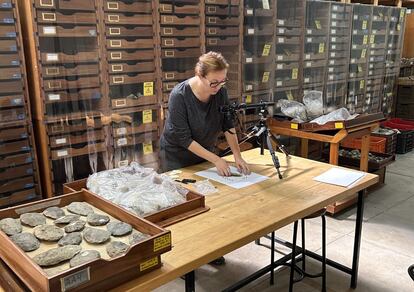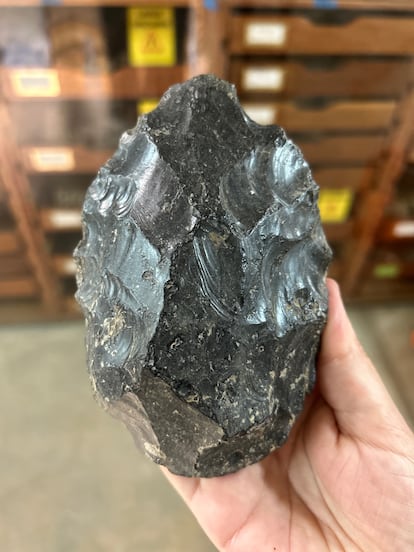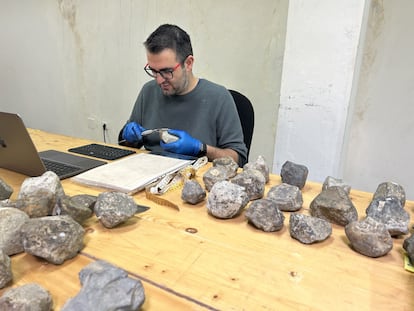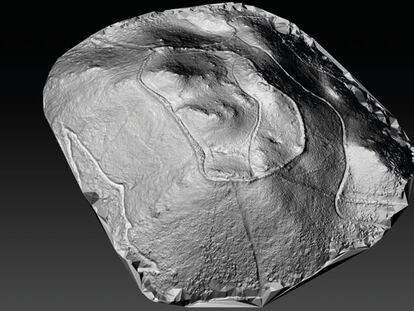How the first mass tool workshop in history functioned 1.2 million years ago
Researchers from the University of Vigo and the Complutense University of Madrid discover a stock of lithic tools in Ethiopia, revealing the ‘planning ability’ of Homo erectus

Amid the unstoppable river floods of the 2011 monsoon season in Thailand, the factories of several multinational technology companies like Sony and Western Digital were flooded and inaccessible. Millions of hard disks, graphics cards and external memory were lost under the mud in the disaster caused by the torrential rains, resulting in shortages around the world. Over 1.2 million years ago, forces of nature facilitated—and then fixed and saved forever—another large-scale workshop’s stock. Simbiro III, part of Ethiopia’s Melka Kunture archaeological site—a current candidate to become a UNESCO World Heritage site—has artifacts up to two million years old (from the Olduvayense and Acheulean periods). An Italian-Spanish research team—which includes researchers Eduardo Méndez-Quintas and Andrea Serodio of the University of Vigo (Spain) and Joaquín Panera and Susana Rubio of the Complutense University of Madrid—is studying the site. Led by Margherita Mussi, of Rome’s University of Sapienza, the group discovered the first known mass workshop in this enclave, which has a large stock of about 120 bifaces per square meter.
Ninety-nine percent of the pieces are carved from the same volcanic material, obsidian, and adhere to a shape that seems standardized, as if all the workers wanted to reproduce a prototype, using practically the same strokes. According to the archaeologists, who published their findings in the journal Nature Ecology & Evolution, this activity was concentrated at the site to take advantage of the accumulation of rocks from volcanic activity, which were dragged and deposited by the Simbiro stream, a tributary of the Awash River. Homo erectus knew how to avail itself of the opportunity this presented, demonstrating their “capacity for planning and anticipation” through the separation of activities much earlier than previously believed. Prior to this discovery, it was thought that “planning mentality” as a characteristic of hominids developed only 500,000 years ago.

The first mass workshop for cutting tools made of the black glass spat out by the surrounding volcanoes remained trapped in a stratum five meters deep since the Pleistocene, visible along a bluff 15 meters long on the right bank of the Simbiro. Lithic axes have accumulated there since the Pleistocene; the tools were carved from the pebbles deposited after seasonal floods, in the middle of a landscape that, at the time was probably pasture with typical wetland plants from the cyperaceae family (such as reeds and papyrus) and coniferous forests.
Located in the upper reaches of the Awash, about 2,100 meters above sea level, the site flooded seasonally. The meandering river provided obsidian boulders, while hominids, according to the scientific article, “developed new techniques” for taking advantage of the material’s qualities to produce very sharp and “highly standardized” tools. The half-meter-thick stratum that reveals this organized activity is situated in the so-called C level: in this layer, excavation done by the Italian-Spanish Archaeological Mission of Melka Kunture and Balchit found a deposit of 578 accumulated tools (575 of which were obsidian) in only 4.8 square meters. “The same density of artifacts” appears “in plain sight” along the cliff, the archaeologists explain. The site contained only bifaces, almond-shaped tools carved on both sides with the fragments and debris removed in the production process.
A ton of bifaces
In this area, there was almost no trace of animal fossils, which were found in the same site’s other upper and lower levels and, along with volcanic ashes, helped date the period in which this enclave functioned. It was a “specialized workshop,” as described by Eduardo Méndez-Quintas, one of the international project’s co-directors alongside Margherita Mussi and Joaquín Panera. The tools show a high degree of sophistication, in what seems to be the “repeated and conscious search for a specific morphology by the groups of Homo erectus that occupied the site,” the expert says. According to the article, the obsidian tools measure about 11.5 centimeters long by eight centimeters in the widest part and weigh an average of 312 grams. Each one was made with about 37 blows. The archaeologists estimate that the Simbiro cliff site may contain an industrial stock of a ton of bifaces.

The discovery makes Simbiro III “a unique case and the world’s oldest documented example of this type of behavior,” says Méndez-Quintas, who is affiliated with the University of Vigo’s Archaeology, Antiquity and Territory Working Group. Over 1.2 million years ago, Homo erectus’ living situation was “a functionally compartmentalized space, with specific places for producing the tools” and other places for using them.
The Melka Kunture archaeological site covers about 70 enclaves in an area of 80 square kilometers. Located 50 kilometers south of Addis Ababa on a vast plateau far from the epicenter of the war that has devastated the Tigray region in the north of the country over the last two years, it is one of Africa’s richest sites and has been investigated for 60 years. The findings have yielded important information about human evolution but thus far, little has been written about them in the scientific literature. The Spanish group that regularly works at the site is also affiliated with the Institute of Evolution in Africa in Madrid and the Center for Research on Human Evolution in Burgos. The discovery may end up being a mere prelude to other findings, which, the research team says, would shatter some established ideas about the hominids that inhabited that territory. UNESCO is currently deciding whether to name Melka Kunture a World Heritage Site.
Sign up for our weekly newsletter to get more English-language news coverage from EL PAÍS USA Edition
Tu suscripción se está usando en otro dispositivo
¿Quieres añadir otro usuario a tu suscripción?
Si continúas leyendo en este dispositivo, no se podrá leer en el otro.
FlechaTu suscripción se está usando en otro dispositivo y solo puedes acceder a EL PAÍS desde un dispositivo a la vez.
Si quieres compartir tu cuenta, cambia tu suscripción a la modalidad Premium, así podrás añadir otro usuario. Cada uno accederá con su propia cuenta de email, lo que os permitirá personalizar vuestra experiencia en EL PAÍS.
¿Tienes una suscripción de empresa? Accede aquí para contratar más cuentas.
En el caso de no saber quién está usando tu cuenta, te recomendamos cambiar tu contraseña aquí.
Si decides continuar compartiendo tu cuenta, este mensaje se mostrará en tu dispositivo y en el de la otra persona que está usando tu cuenta de forma indefinida, afectando a tu experiencia de lectura. Puedes consultar aquí los términos y condiciones de la suscripción digital.










































